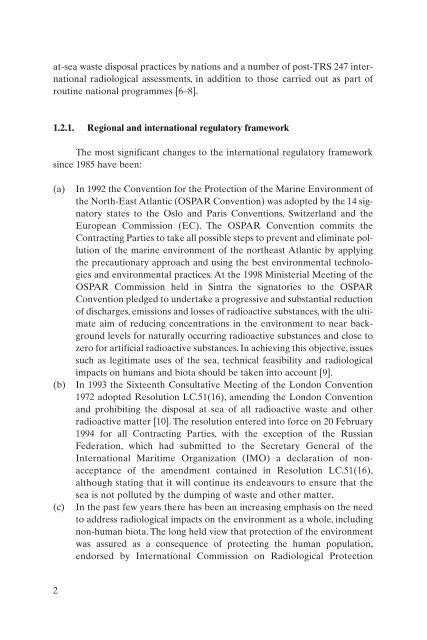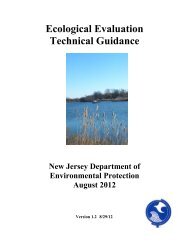Sediment Distribution Coefficients and Concentration Factors for ...
Sediment Distribution Coefficients and Concentration Factors for ...
Sediment Distribution Coefficients and Concentration Factors for ...
You also want an ePaper? Increase the reach of your titles
YUMPU automatically turns print PDFs into web optimized ePapers that Google loves.
at-sea waste disposal practices by nations <strong>and</strong> a number of post-TRS 247 internationalradiological assessments, in addition to those carried out as part ofroutine national programmes [6–8].1.2.1. Regional <strong>and</strong> international regulatory frameworkThe most significant changes to the international regulatory frameworksince 1985 have been:(a)(b)(c)In 1992 the Convention <strong>for</strong> the Protection of the Marine Environment ofthe North-East Atlantic (OSPAR Convention) was adopted by the 14 signatorystates to the Oslo <strong>and</strong> Paris Conventions, Switzerl<strong>and</strong> <strong>and</strong> theEuropean Commission (EC). The OSPAR Convention commits theContracting Parties to take all possible steps to prevent <strong>and</strong> eliminate pollutionof the marine environment of the northeast Atlantic by applyingthe precautionary approach <strong>and</strong> using the best environmental technologies<strong>and</strong> environmental practices. At the 1998 Ministerial Meeting of theOSPAR Commission held in Sintra the signatories to the OSPARConvention pledged to undertake a progressive <strong>and</strong> substantial reductionof discharges, emissions <strong>and</strong> losses of radioactive substances, with the ultimateaim of reducing concentrations in the environment to near backgroundlevels <strong>for</strong> naturally occurring radioactive substances <strong>and</strong> close tozero <strong>for</strong> artificial radioactive substances. In achieving this objective, issuessuch as legitimate uses of the sea, technical feasibility <strong>and</strong> radiologicalimpacts on humans <strong>and</strong> biota should be taken into account [9].In 1993 the Sixteenth Consultative Meeting of the London Convention1972 adopted Resolution LC.51(16), amending the London Convention<strong>and</strong> prohibiting the disposal at sea of all radioactive waste <strong>and</strong> otherradioactive matter [10]. The resolution entered into <strong>for</strong>ce on 20 February1994 <strong>for</strong> all Contracting Parties, with the exception of the RussianFederation, which had submitted to the Secretary General of theInternational Maritime Organization (IMO) a declaration of nonacceptanceof the amendment contained in Resolution LC.51(16),although stating that it will continue its endeavours to ensure that thesea is not polluted by the dumping of waste <strong>and</strong> other matter.In the past few years there has been an increasing emphasis on the needto address radiological impacts on the environment as a whole, includingnon-human biota. The long held view that protection of the environmentwas assured as a consequence of protecting the human population,endorsed by International Commission on Radiological Protection2
















